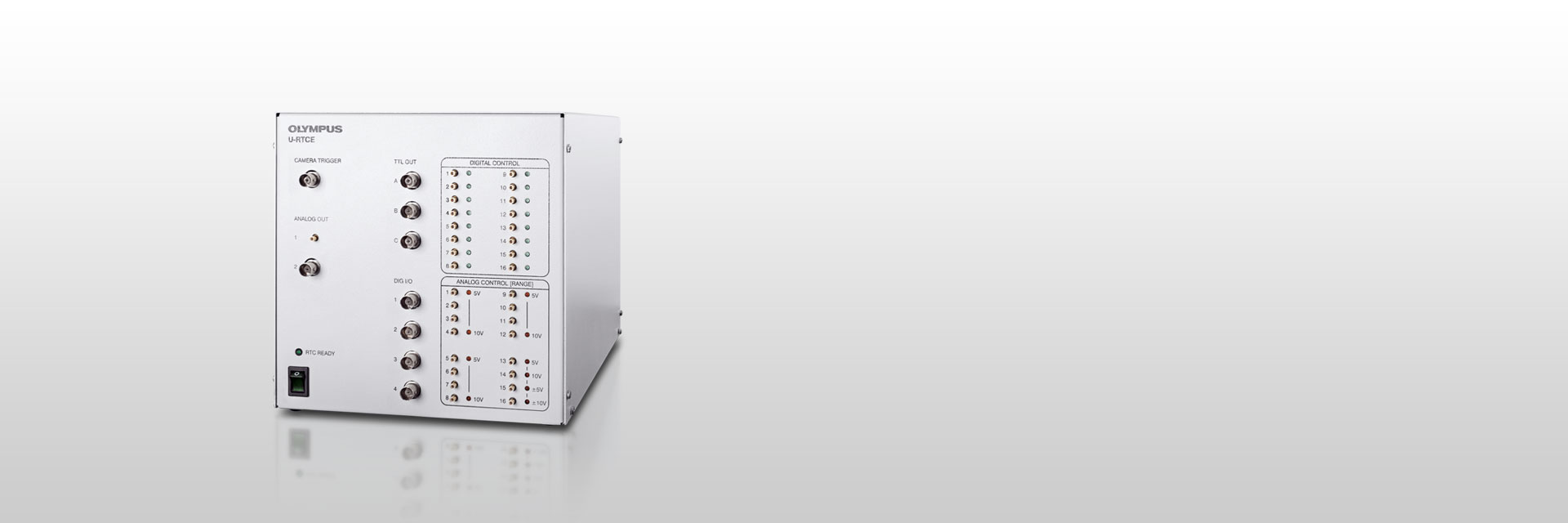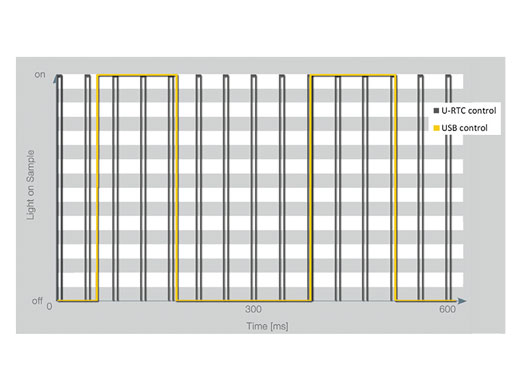Not Available in Your Country
Sorry, this page is not
available in your country.
Overview
 | Complex live-cell imaging experiments such as fluorescence recovery after photo bleaching, single molecule detection, and ultrafast synchronized 3D-stacking require high temporal resolution and control flexibility. The U-RTCE real-time controller (RTC) meets these demanding requirements with high-precision timing and parallelized control that optimize overall system performance. Both enable precise synchronization between accessory devices that translates directly into fast experiment execution and improved cell viability. The U-RTCE controller is broadly compatible with many TTL and analog controlled systems, including piezoelectric focus and positioning devices, laser combiner and LED excitation systems, as well as a broad range of cameras and acquisition devices, and more. |
|---|
High-Precision Timing and High AccuracyThe U-RTCE real-time controller features an independent CPU board that provides fast, parallel experiment execution without delays, even in complex experimental setups. This not only leads to extremely high timing accuracy and a precision of smaller than 2 µs, but also minimizes idle times, which is an essential requirement for high-speed imaging. Owing to the U-RTCE system’s fast and accurate real-time control, your experiments, especially live-cell experiments, benefit from:
Precise device control, excellent timing precision, and high accuracy are prerequisites that reduce sample bleaching, increase cell viability, and help ensure data reproducibility. |
The effective sample illumination time using the RTC control (gray) is reduced up to 25 times compared to USB control (blue). |
The precision and speed (i.e., images taken per time) of experiment setups is more accurate and faster when the experiment is controlled via the RTC (blue) compared to PC control only (orange). Measurements were performed by using Lumen Dynamics XLED1 light source, Andor iXON 897 EMCCD camera and a light meter at the objective lens. Data were acquired with 5 ms exposure running the camera as fast as possible. The combination of fast, real-time experiment performance and an easy-to-use software GUI is unique in life science microscopy. |
Intelligent ConnectionsHigh-end imaging hardware including cellTIRF, cellFRAP, filter wheels, and shutters are easily connected, configured, and controlled using cellSens™ software through the RTC. The extended real-time controller features a number of ports dedicated to efficiently controlling generic peripheral components at high speeds. Up to 23 trigger output ports provide TTL synchronization such as switching light sources on or off, and up to 18 analog output ports serve, for example, for light source intensity control or precise piezo Z-positioning. Up to four digital input ports can be used for handshake connections with third-party vendor devices or to wait for triggers caused by experiment events. |
System IntegrationThe real-time controller is fully integrated within cellSens software. Olympus/Evident and third-party devices connected to the U-RTCE controller can be directly controlled using the cellSens Graphical Experiment Manager (GEM). This combination of hardware and easy-to-use software GUI enables you to set up even the most complex experiments and to trigger them with one click. |
The combination of fast, real-time experiment performance combined with an easy-to-use software GUI is unique in life science microscopy. |
Need assistance? |
Specifications
| Camera (Synchronization) via TTL trigger | Camera Trigger Port |
|---|---|
| Light source intensity control, Piezo Z-controllers and other analogue controlled devices |
Analog 1 & 2 (14 bit) - BNC, SMB
analog Control (16x) - SMB |
|
Synchronization of TTL controlled devices e.g. shutters,
TTL controlled laser/LED on-off, cellFRAP controller |
TTL out (3x) – BNC
DIG Control (16x) - SMB |
| Handshake with other devices or synchronization of sxperiments via wait-for-trigger, e.g. cellFRAP controller, camera trigger out, U-CBH trigger out |
DIG I/O (4x)
(BNC) |
| ODB fast devices: U-FSHA, U-FFWO/R, U-STC, MT20E, cell* lasers, celltirf family | Supported |
| PC connection / cellSens | USB 2.0 |




